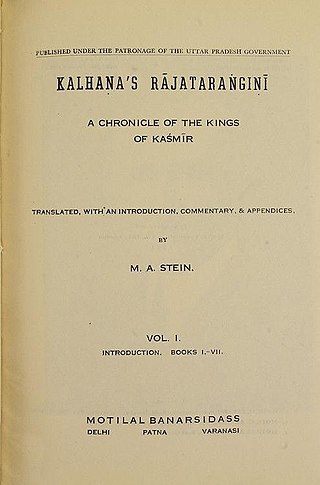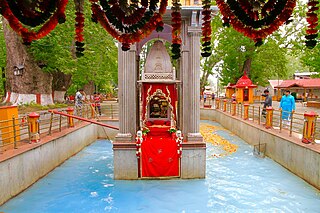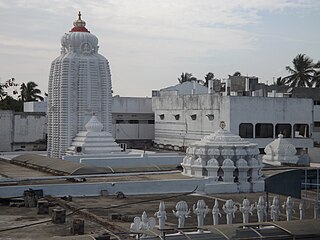
Srinagar is a city in Indian-administered Jammu and Kashmir in the disputed Kashmir region. It is the largest city and summer capital of Jammu and Kashmir, which is an Indian-administered union territory. It lies in the Kashmir Valley along the banks of the Jhelum River, and the shores of Dal Lake and Anchar Lakes, between the Hari Parbat and Shankaracharya hills. The city is known for its natural environment, various gardens, waterfronts and houseboats. It is also known for traditional Kashmiri handicrafts like the Kashmir shawl, papier-mâché, wood carving, carpet weaving, and jewel making, as well as for dried fruits. It is the second-largest metropolitan area in the Himalayas.

The Kashmiri Pandits are a group of Kashmiri Hindus and a part of the larger Saraswat Brahmin community of India. They belong to the Pancha Gauda Brahmin group from the Kashmir Valley, located within the Indian union territory of Jammu and Kashmir. Kashmiri Pandits are Hindu Kashmiris native to the Kashmir Valley, and the only remaining Hindu Kashmiris after the large-scale of conversion of the Valley's population to Islam during the medieval times. Prompted by the growth of Islamic militancy in the valley, large numbers left in the exodus of the 1990s. Even so, small numbers remain.
Jonaraja was a Kashmiri historian and Sanskrit poet. His Dvitīyā Rājataraṅginī is a continuation of Kalhana's Rājataraṅginī and brings the chronicle of the kings of Kashmir down to the time of the author's patron Zain-ul-Abidin. Jonaraja, however, could not complete the history of the patron as he died in the 35th regnal year. His pupil, Śrīvara continued the history and his work, the Tritīyā Rājataraṅginī, covers the period 1459–1486.
Shrivara [Śrīvara] wrote a work on the history of Kashmir that adds to the previous works of Kalhana and Jonaraja, thereby providing an update of the history of Kashmir till 1486 CE. Śrīvara served at the courts of the four Šāhmīrī Sulṭāns Zayn al-ʿĀbidīn, Ḥaydar Šāh, Ḥasan Šāh and Maḥmūd Šāh until 1486, when Fatḥ Šāh took power for the first time. Holding this office since 1459, Śrīvara concentrated on writing the history he had personally witnessed. Unlike his predecessors Kalhaṇa and Jonarāja, who had completed the history of Kashmir in retrospect and continued it up to their respective times, Śrīvara, as a contemporary historian, was left with only occasional retrospective additions going back to 1451. His accounts, the Jaina- and Rājataraṅgiṇīs, written as an eyewitness, are characterised by a remarkably detailed density that hardly leaves out any aspect of his coeval horizon of observation and reflection on everyday Kashmiri culture, court life, politics, religion and society. The consolidation of the religious and political influence of a group of Sayyids, who had migrated from Baihaq in Iran under earlier Šāhmīrī Sulṭāns such as Sikandar, and the dynamics triggered by their attempts under Ḥasan Šāh and Maḥmūd Šāh to participate in the reign, culminated in a devastating civil war between factions of indigenous Kashmiris (kāśmīrika) and the immigrants from abroad. These events are of particular research interest for tracing the historical ramifications of the Islamisation process in Kashmir. In terms of richness of detail of everyday culture also in its material aspects, Śrīvara’s work is by far the most abundant source on Indo-Persian rule in early modern India and the living conditions under omnipresent threats of famines, natural disasters and warfare. Śrīvara’s work breaks off with Maḥmūd Šāh’s (first) dethronement followed by Fatḥ Šāh’s ascension to the throne. The abrupt end of his account was however not caused by Śrīvara’s death. Nineteen years later we hear from him again in the prelude to his Sanskrit translation of Jāmi’s (1414–1492) Persian Yusof o Zoleykhā, entitled the Kathākautuka. Śrīvara dated his prologue April 18, 1505. The sudden interruption of Śrīvara’s Rājataraṅgiṇī, coinciding with the transition of power in 1486, should therefore be sought in his removal from the position of court biographer. Śrīvara had completed his Sanskrit rendering of Jāmi’s Persian composition (1483) only twenty-two years after its publication in Herat.
Shingara, better known as Sultan Sikandar Shah Miri, also by his sobriquet Sikandar Butshikan was the seventh Sultan of Kashmir and a member of Shah Mir dynasty who ruled from 1389 until his death in 1413.

Rājataraṅgiṇī is a metrical legendary and historical chronicle of the north-western part of Indian sub-continent, particularly the kings of Kashmir. It was written in Sanskrit by Kashmiri historian Kalhana in the 12th century CE.

Buddhism was an important part of the classical Kashmiri culture, as is reflected in the Nilamata Purana and Kalhana's Rajatarangini. Buddhism is generally believed to have become dominant in Kashmir in the time of Emperor Ashoka, although it was widespread there long before his time, enjoying the patronage not only of Buddhist rulers but of Hindu rulers too. From Kashmir, it spread to the neighbouring Ladakh, Tibet and China proper. Accounts of patronage of Buddhism by the rulers of Kashmir are found in the Rajatarangini and also in the accounts of three Chinese visitors to Kashmir during 630-760 AD.

The Shah Mir dynasty or the House of Shah Mir, was a Kashmiri dynasty that ruled the Kashmir Sultanate in the Indian subcontinent. The dynasty is named after its founder, Shah Mir.

Ghiyath al-Din Shah Rukh Shahi Khan, commonly known as Zayn al-Abidin the Great, was the ninth sultan of the Kashmir Sultanate, ruling first from 1418 to 1419 and then from 1420 to 1470. He was famously called Budshah by his subjects.

Awantipora or Avantipur or Aavantipur, known as Woontpor in Kashmiri, is a town, just opposite of Pulwama city, on the banks of the river Jhelum in the Pulwama district of Jammu and Kashmir, India.

Kheer Bhawani,Ksheer Bhawani or the Ragnya Devi temple is a Hindu temple situated at a distance of 25 kilometres (16 mi) north-east of Srinagar, Jammu and Kashmir, India, in the village of Tulmulla in Ganderbal. It is dedicated to the Hindu goddess Kheer Bhavani constructed over a sacred spring. As is the custom with Hindu deities, the goddess has many names including Ragnya or Rajna, along with variations in honorifics such as Devi, Mata or Bhagavati. The term kheer refers to a milk and rice pudding that is offered to propitiate the goddess. Kheer Bhawani is sometimes translated as 'Milk Goddess'. The worship of Kheer Bhawani is universal among the Hindus of Kashmir, most of them who worship her as their protective patron deity Kuladevi.

Sharada Peeth is a ruined Hindu temple and ancient centre of learning located in the Neelum Valley of Pakistan-administered Azad Kashmir in the disputed Kashmir region. Between the 6th and 12th centuries CE, it was among the most prominent temple universities in the Indian subcontinent. Known in particular for its library, stories recount scholars travelling long distances to access its texts. It played a key role in the development and popularisation of the Sharada script in North India, causing the script to be named after it, and Kashmir to acquire the moniker "Sharada Desh", meaning "country of Sharada".

Kashmiri Muslims are ethnic Kashmiris who practice Islam in the Kashmir Valley, an area that includes the India-administered territories of Jammu and Kashmir and Ladakh, the Pakistan-administered territories of Azad Kashmir and Gilgit-Baltistan, and the Chinese-administered territories of Aksai Chin and the Trans-Karakoram Tract. The majority of Kashmiri Muslims are Sunni. They refer to themselves as "Koshur" in their mother language.
Islam is the majority religion practised in Kashmir, with 97.16% of the region's population identifying as Muslims as of 2014. The religion came to the region with the arrival of Mir sayed Ali shah Hamdani, a Muslim Sufi preacher from Central Asia and Persia, beginning in the early 14th century. The majority of Kashmiri Muslims are Sunni Muslims, and Shias account for between 20% and 25% of the Muslim population, who mostly reside in north and central Kashmir. They refer to themselves as "Koshur" in their mother language. Non-Kashmiri Muslims in Kashmir include semi-nomadic cowherds and shepherds, belonging to the 𝙂𝙪𝙟𝙟𝙖𝙧𝙨 and Bakarwal communities.
Rinchan Shah, born as Lhachen Rinchan Bhoti and also known by his titular name Sadr'ud-Din Shah, was the founder and the first Sultan of the Sultanate of Kashmir from 1320 to 1323. Originally said to have been a Ladakhi Buddhist, he converted to Islam, becoming the first Muslim ruler of Kashmir.

Parihaspora or Parihaspur or Paraspore or Paraspur was a small town 22 kilometres (14 mi) northwest of Srinagar in the Kashmir Valley. It was built on a plateau above the Jhelum River. It was built by Lalitaditya Muktapida and served as the capital of Kashmir during his reign.

The Exodus of Kashmiri Hindus, or Pandits, is their early-1990 migration, or flight, from the Muslim-majority Kashmir valley in Indian-administered Kashmir following rising violence in an insurgency. Of a total Pandit population of 120,000–140,000 some 90,000–100,000 left the valley or felt compelled to leave by the middle of 1990, by which time about 30–80 of them are said to have been killed by militants.
Walter Slaje is an Austrian Indologist.

Arasavalli Sun Temple is a temple for Lord Surya, the solar deity, at Arasavalli in the Indian state of Andhra Pradesh. It is located in Arasavalli Village 1 km east of Srikakulam. It is believed that the temple was built in 7th century CE by King Devendra Varma, a great ruler of Eastern Ganga Dynasty of Kalinga. The present structure is largely a result of 18th-century renovations. The temple was built in Rekha deula style of Kalinga Architecture like Puri Jagannath temple of Odisha. This temple is considered one of the oldest sun temples in India. The temple is one of the two major temples who worship Lord Surya in India. The other two are the Konark Sun Temple, Odisha and Martand Sun Temple, Jammu and Kashmir.






















